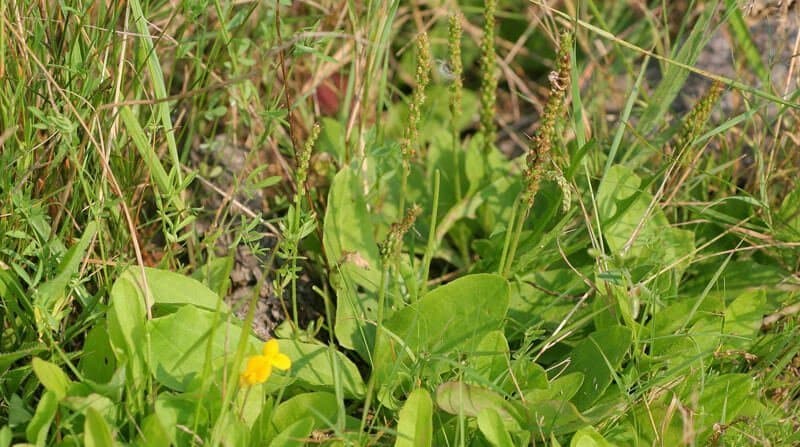There are four major plantain weeds that grow in lawns across the UK and they are;
- Greater Plantain or Plantago Major
- Ribwort Plantain or Plantago Lanceolata
- Hoary Plantain or Plantago Media
- Buckshorn Plantain or Plantago Coronopus
Plaintain weeds can tell you a lot about the condition of your lawn. They typically grow in neglected lawns with compacted soil.
It also looks horrible and has a nasty habit of killing the grass underneath and around it. So I’m going to show you how to get rid of plantain weeds and prevent them from returning.
Plantain Weeds in a Nutshell
In order to remove plantain weeds from your lawn and prevent them from growing back, it will help to know a few things about them;
Appearance
The treatment of plantain weeds is very much the same but still, it’s useful to know how to tell the difference between each species.
Greater Plantain
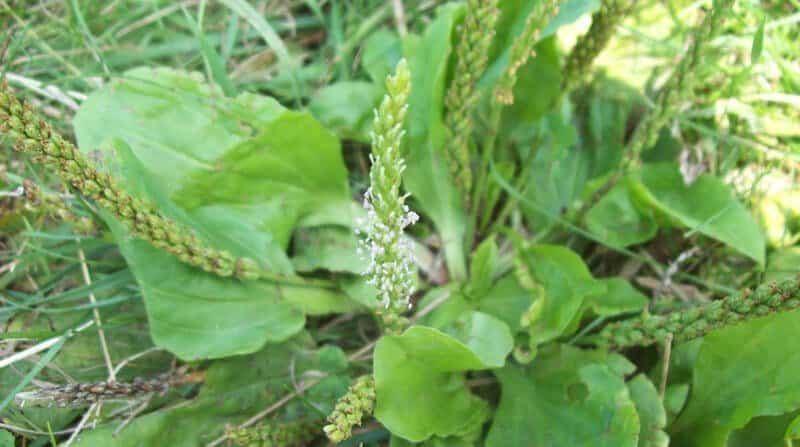
Plantago Major forms a flat rosette of broad, oval-shaped leaves that grow between 5cm – 20cm long and up to 10cm wide. Each leaf has between 5-9 with distinctive veins. These rosettes grow in a prostate manor close to the ground which kills the grass underneath.
The flowers which are visible between May and October, grow in a dense spike ranging from 5cm – 15cm long on top of a long stem which can grow up to 15cm long.
Hoary Plantain
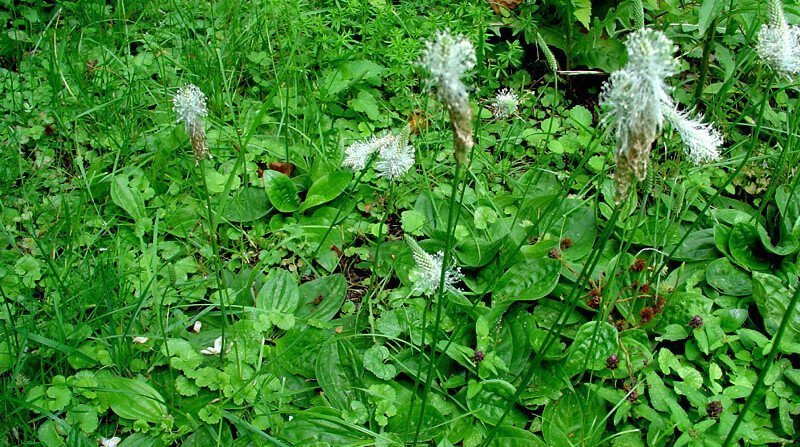
Hoary Plantain or Plantago media has similar leaves to the Greater Plantain weed in terms of shape. But they’re smaller and have a much shorter stalk, some leaves don’t have a stalk at all.
The flower heads are much shorter but wider and you’ll see them between May and August.
Ribwort Plantain
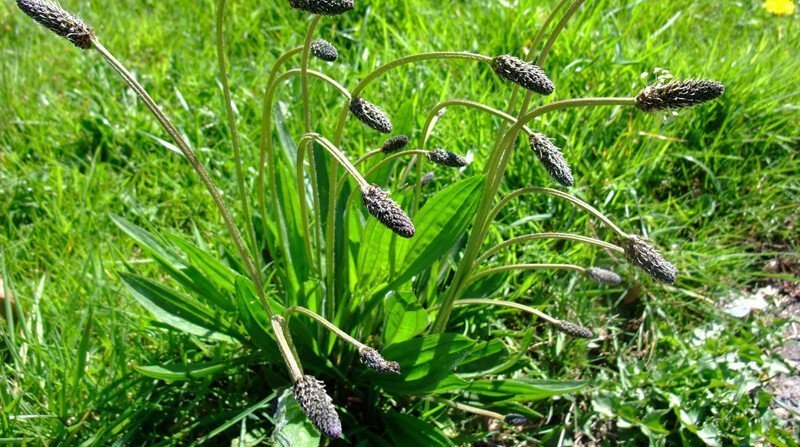
The leaves are a narrow spear shape which is where the name Narrow Leaf Plantain comes from. They have fine hairs on them and 3-5 distinctive veins that run parallel to each other. These leaves can grow close to the ground or erect.
Flowers are visible between April and October. They’re cylindrical in shape and sit on top of silky, hairy stems which can grow up to 40cm long if not dealt with.
Buckshorn Plantain
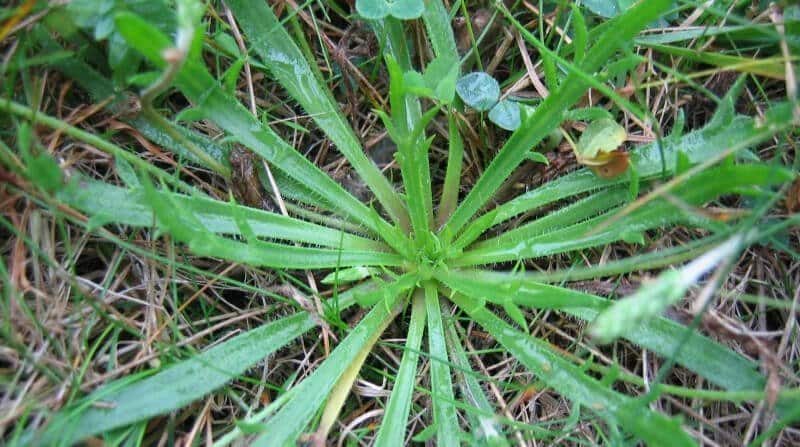
Buckshorn Plantain or Plantago coronopus is also known as Starweed.
The leaves on Buckhorn Plantain are even narrower than Ribwort. They’re more of a lance shape and can grow up to 25cm long.
They have dense spikes of flowers which can curve upwards to around 10cm in height and are seen between May and October.
A Perennial Weed
Plantain weeds are perennial which means the same plant will grow back each year if it’s not dealt with.
They have dense, fibrous root systems that make them very tolerant to drought and like Clover, they’re often the only green part of a lawn when the weather is particularly dry.
Preferred Habitat
Greater Plantain and Ribwort Plantain happily grow in most soil types but they do especially well in compacted soils. If you have a lot of these weeds in your lawn, it could be a sign of soil compaction.
How to Remove Pantain Weeds From Your Lawn
Like any weed, try to remove plantain weeds as soon as you see them and before they have a chance to produce seeds. The longer you leave them to establish itself, the tougher they will be to remove.
There are a couple of ways to deal with them;
Remove Them by Hand
If there are only one or two weeds to deal with, removing them by hand is the best way of getting rid of them.
Be careful to remove all of the roots or as much as you can see. Plantain weeds can grow back from just a segment of the root. So be thorough!
To achieve complete control it might take more than one attempt.
Kill the Weed with a Spot Spray Selective Weed Killer
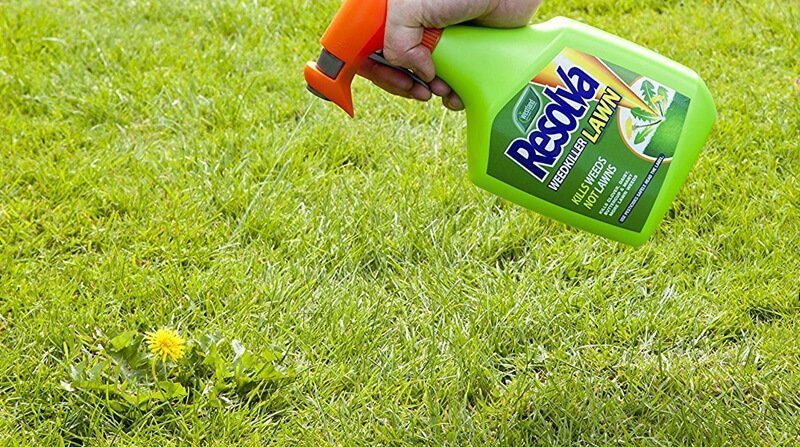
A weedkiller gets into and kills the weed at the roots. So blasting plantain weeds with a spot spray weedkiller will prevent them from growing back.
If you only have one or two weeds in your lawn, choose a spot spray weedkiller like Resolva Spot Spray Weedkiller for Lawns.
- Small spray bottle ideal for small areas
- Non-glyphosate formulation
Spray the Whole Lawn With a Weed Killer Concentrate
If plantain weeds inhabit your lawn then chances are other weeds will too. Especially those that grow well in compacted soil like Black Medick, Daisies and Dandelions.
If you have a lot of weeds in your lawn, spot spraying is useless. Instead, treat the whole lawn with a selective weed killer concentrate.
A selective weedkiller concentrate like Weedol Lawn Weedkiller Concentrate will kill the weeds while being gentle on the grass.
That said, it’s important to dilute the concentrate as per the manufacturer’s instructions. If you make it too strong you will risk killing the grass. Make it too weak however and it might not kill the weeds.
- Apply through a sprayer or watering can
- Non-glyphosate formulation
Read: The Best Lawn Weed Killers: My Top Picks
How to Prevent Plantain Weeds From Growing in Your Lawn
As we now know, Greater Plantain and Ribwort Plantain grow best in heavily compacted soils. So to prevent them from growing in your lawn, you should make changes to the soil.
Also, good lawn care practices will promote grass growth and health. This, in turn, will reduce the chance of any weeds taking over.
Here’s what to do;
Relieve Soil Compaction by Aerating Your Lawn
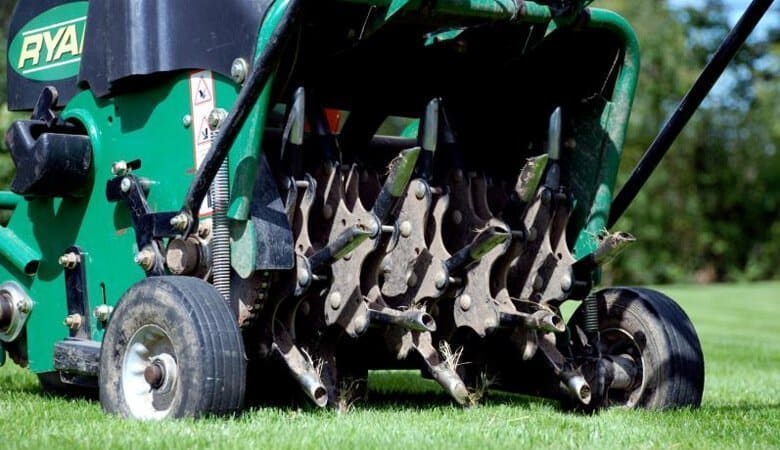
Because plantain weeds grow best in compacted soil it makes sense to relieve the compaction.
Soil compaction occurs on heavily used lawns. Children and pets playing or walking over the same spot on a regular basis cause the soil particles beneath the grass to be pressed together.
This squeezes out air and water that grass relies on for growth. It also makes the ground hard which causes two issues;
- Water, air and other nutrients can’t penetrate the hard soil so the grass is starved of what it needs to grow, and
- Grass roots can’t establish themselves well in overly hard soil.
This results in unhealthy, weak and threadbare grass, the perfect environment for plantain and other weeds to grow in.
Aeration is the process of either spiking your lawn (in the spring) or removing cores of turf by hollow tining (in the autumn). This allows air, water and nutrients to penetrate the soil which gives the grass what it needs to grow.
Hollow tining removes cores of turf from the lawn. This allows the compacted soil particles to relax and spread out, completely relieving compaction and creating space for the grasses roots to grow into.
Read: Lawn Aeration: Everything You Need to Know About Aerating Your Lawn (The Ultimate Guide)
Reduce Lawn Thatch By Scarifying
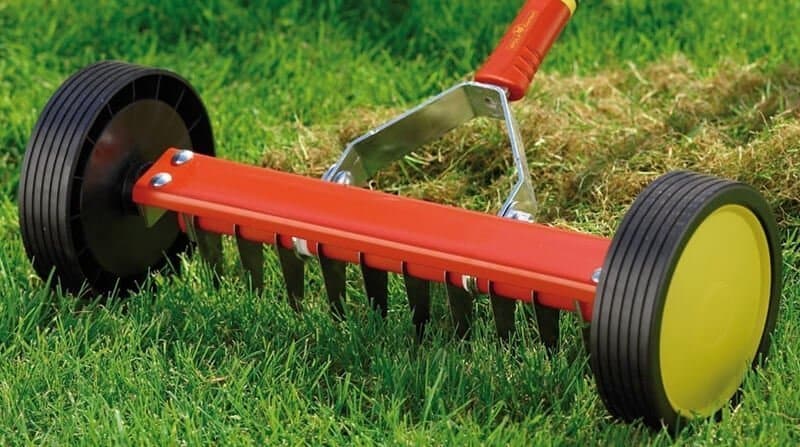
Lawn thatch is a layer of fibrous, organic matter that lies on the surface of the soil in amongst the grass. It’s made up of old grass clippings, new and dead roots and runners.
Some thatch is a good thing because it protects the crown of the grass plant from damage and disease. However, too much can prevent water, air and nutrients from getting into the soil.
These nutrients are vital for your grass to grow and stay healthy. Without them it can’t grow or fight of infestations from weeds or lawn moss.
Scarification uses a machine to tear excess thatch from your lawn. This creates space for water, air and nutrients to penetrate the soil giving the grass what it needs to grow.
Your lawn will look pretty horrific after scarifying but with a good recovery program, it will look better than ever in a short space of time.
Read: Lawn Scarification: Why, When and How to Scarify Your Lawn (The Ultimate Guide)
Read: Looking For a Scarifier? See My Buyers Guide and Recommended Products
Fertilise Your Lawn at Least Once a Year
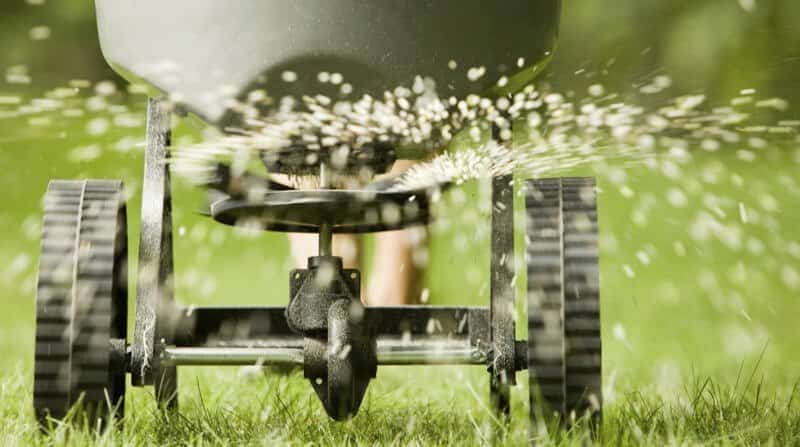
If your lawn has been compacted then I’m willing to be that it’s also lacking in nutrients. In which case you need a apply a good quality fertiliser to get vital nutrients like Nitrogen, Potassium and Phosphate back into the soil.
There’s no point in doing this until you have aerated and scarified. The fertiliser won’t be able to penetrate the soil, it’ll just sit on the surface. So do it after.
You can buy different types of fertiliser products which are designed to be applied at different times of the year. If you’re serious about keeping your lawn in the best possible condition. I’d recommend using these products.
That said, if you just want a lawn that looks decent and you’re not bothered about winning any awards, apply a slow-release fertiliser at least once a year to keep the soil topped up with nutrients.
Read: Lawn Fertiliser: What, Why, When and How to Feed Your Lawn
Also Read: The Best Grass Fertiliser: Which Ones to Use and When
Cut the Grass on a Regular Basis

Finally, mow the grass regularly.
Cutting the grass is by far the most important part of keeping a healthy lawn. It’s also the most overlooked which is why so many people get it wrong.
When grass is healthy it grows, and, if you let it, it will keep growing upwards.
Buy cutting the grass on a regular basis you prevent it from growing upwards so it looks for other ways to grow. This means it grows sideways, producing new side shoots (or runners) that new grass leaves grow from.
These new runners and grass leaves create a thick, lush lawn that prevents weed seeds from reaching the soil and germinating. It also means you don’t cut too much off the grass leaf away at one time.
If you only ever cut the grass every few weeks it won’t grow sideways, it’ll keep growing upwards. Then when you do cut it short, you rob the grass of its water supply and food stores. This shocks it and turns it brown and spiky, even kills it.
So mow the lawn regularly, at least every 10 days between April and October. Take that down to 7 days when conditions for growth are at their best, usually in May and September.
Read: How to Mow a Lawn: There’s More to it Than You Think!
Wrapping Up
Plantain weeds are ugly but they’re not that difficult to remove.
Getting rid of any weeds is less than half the battle. The real work is in preventing them from growing in the first place.
That said, it’s not hard to do. You simply need to make conditions for growing grass more favourable than weeds.
All it takes is a bit of knowledge and the commitment to apply it.
If you have any questions or comments about the killing or removal of plantain weeds, leave a comment below.
I’d also love to see your before and after pictures of your renovated lawn. If you’ve recovered your lawn from a patch full of weeds into a healthy lawn full of lush, green grass, send them in and I’ll share them with the community.
